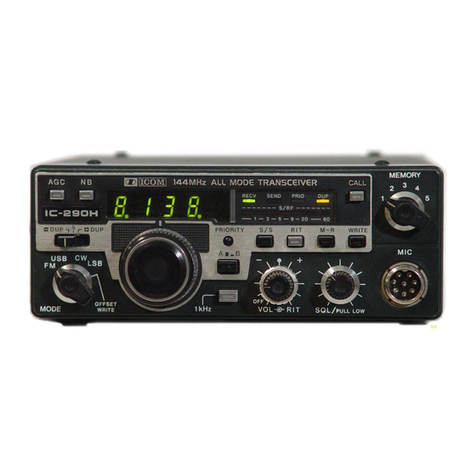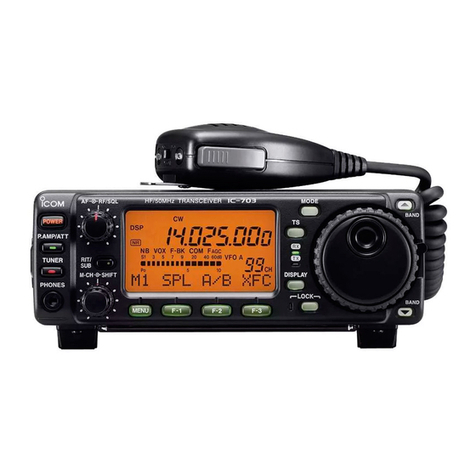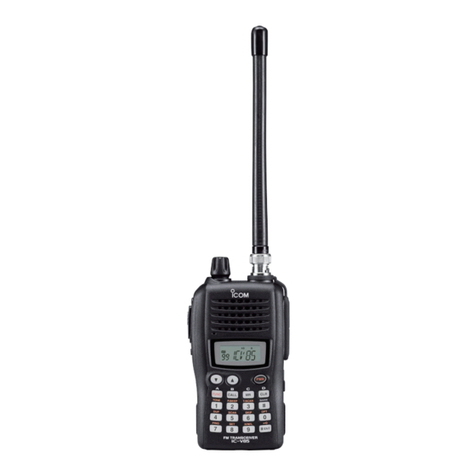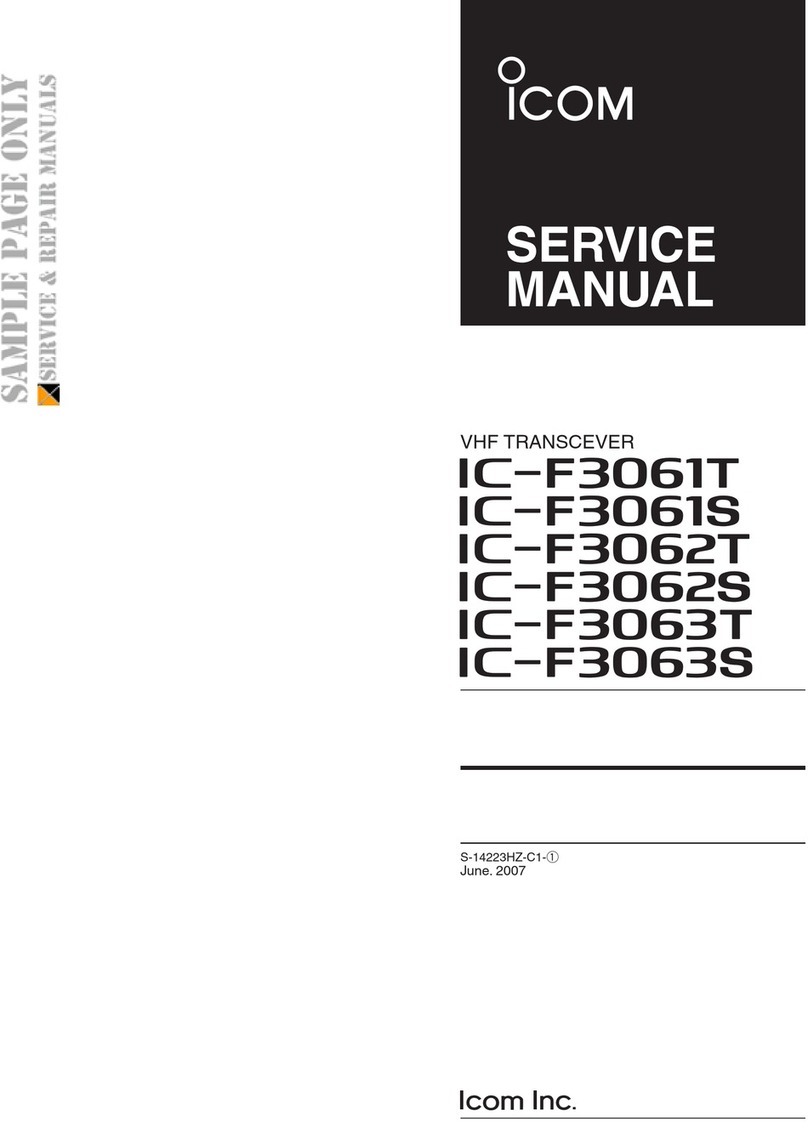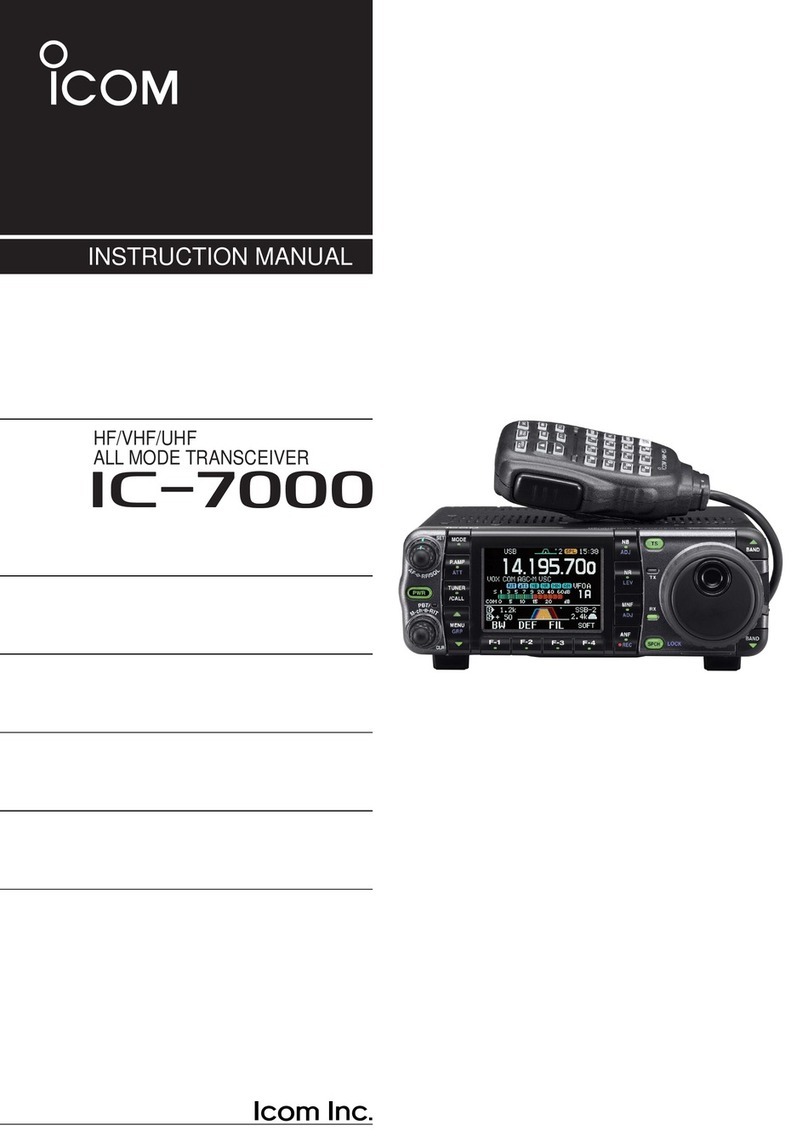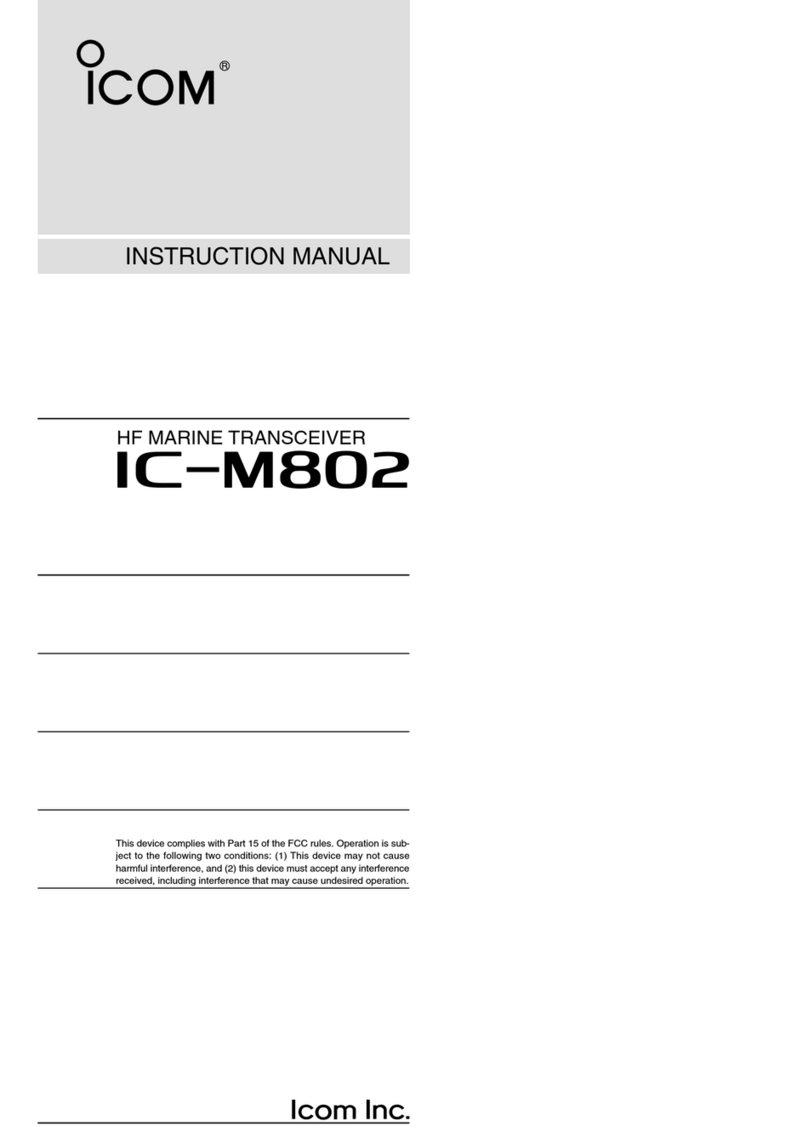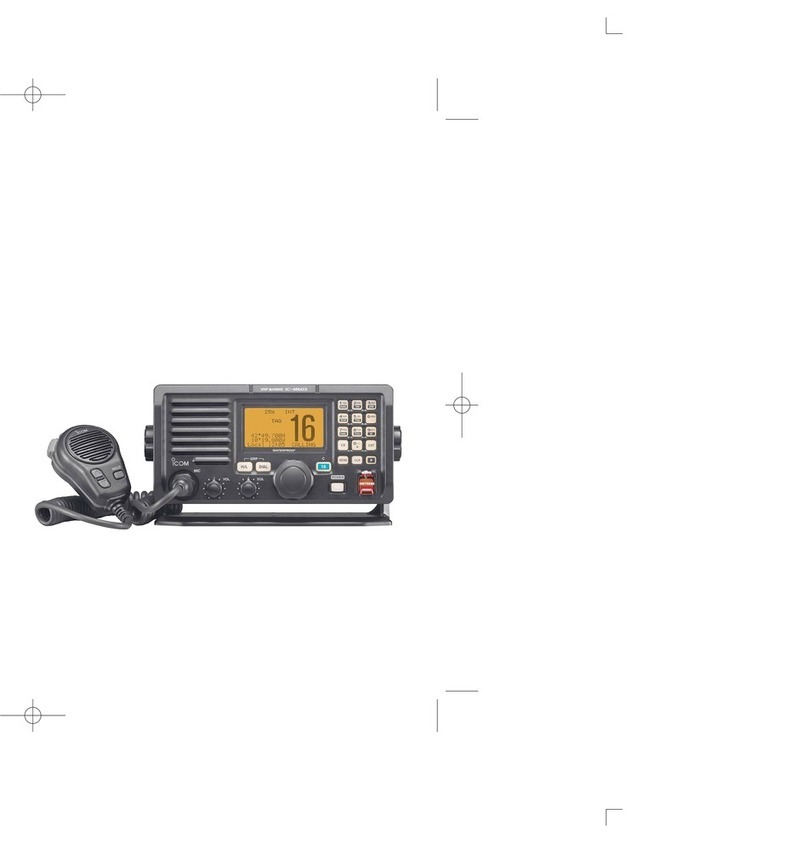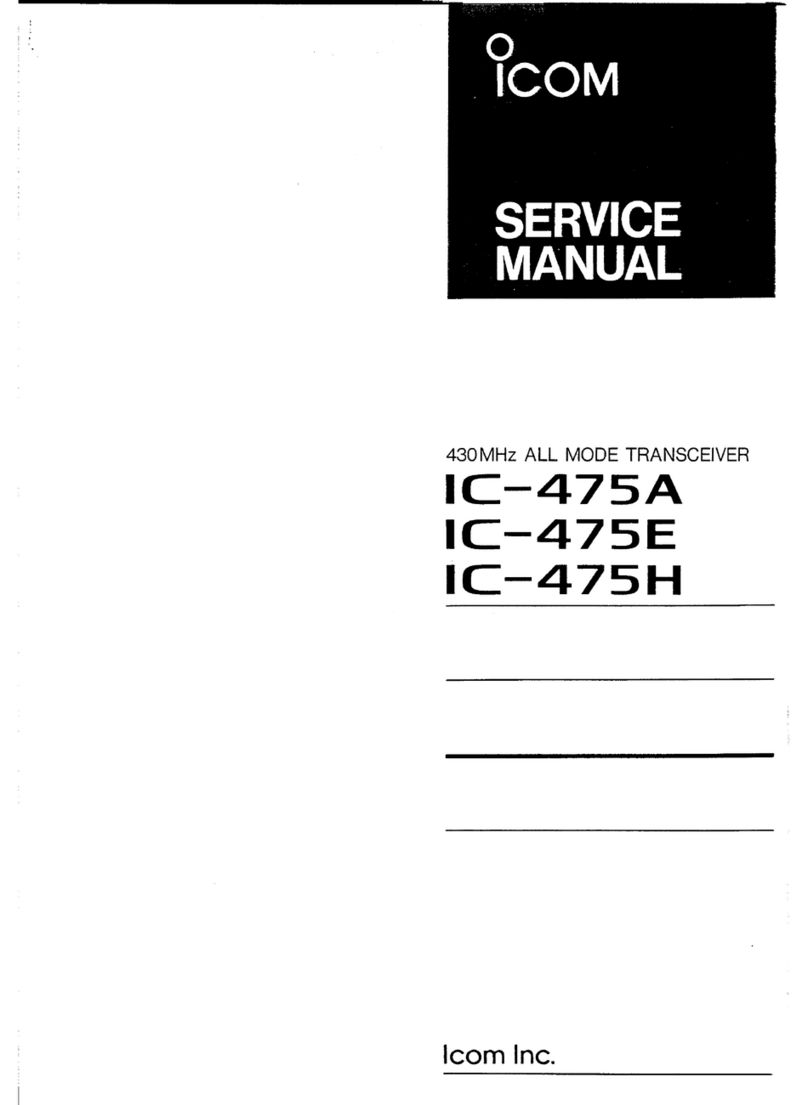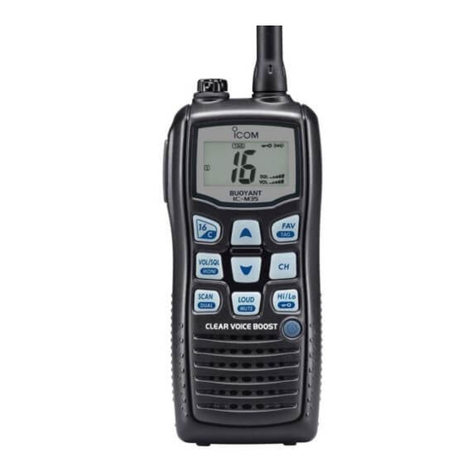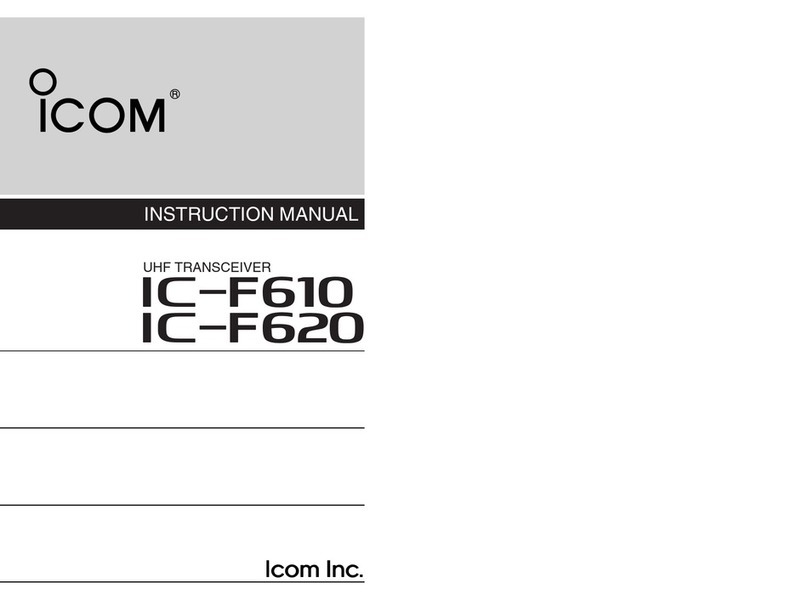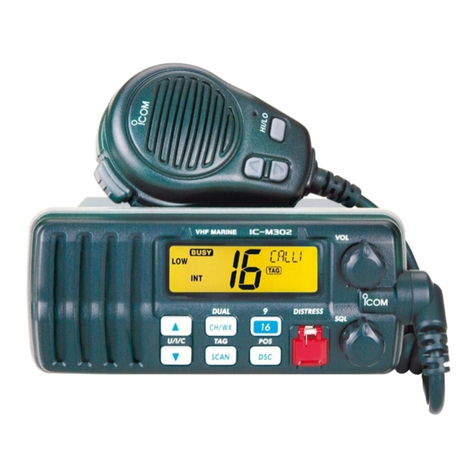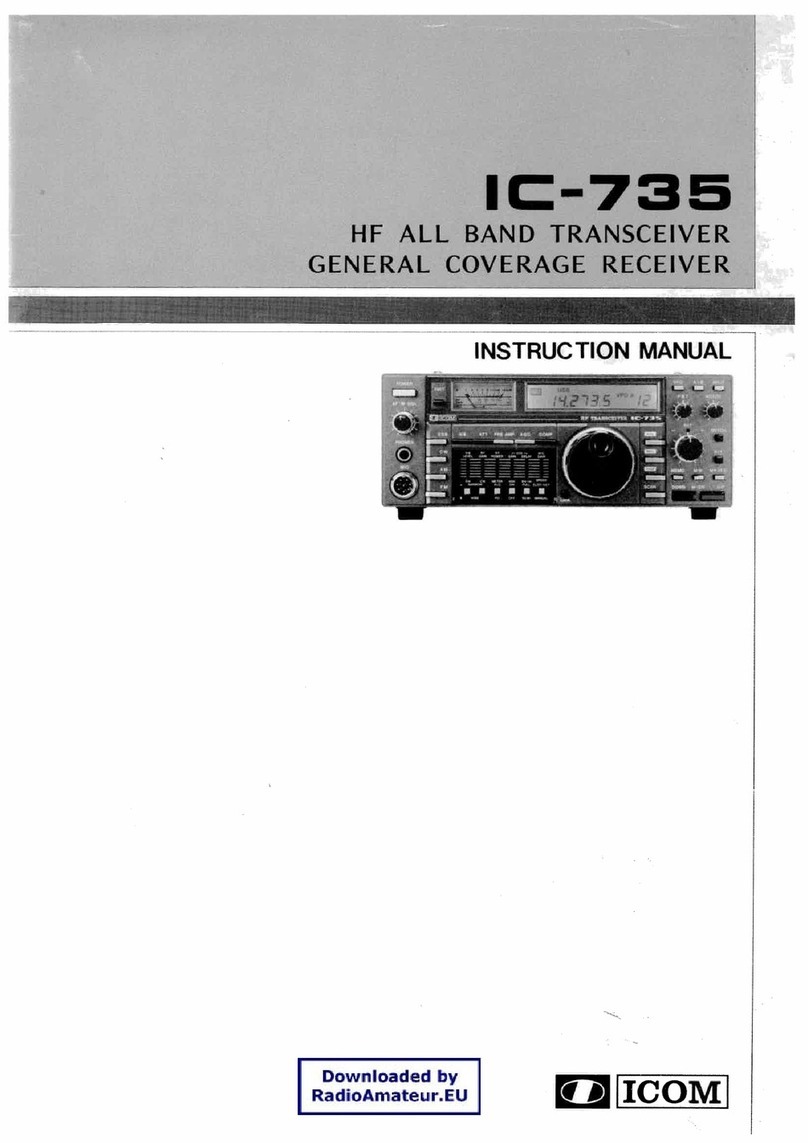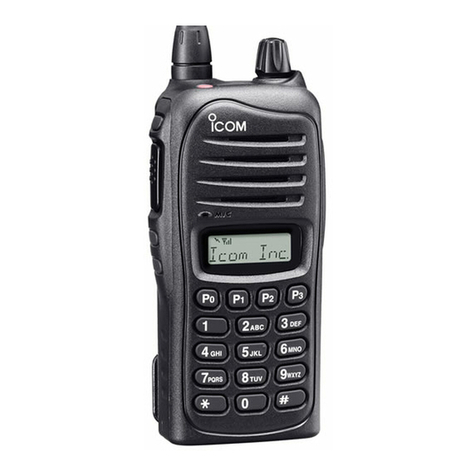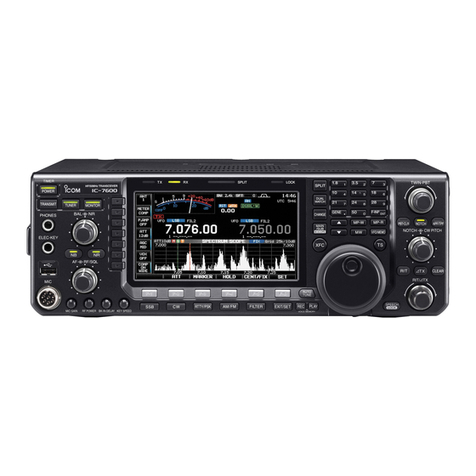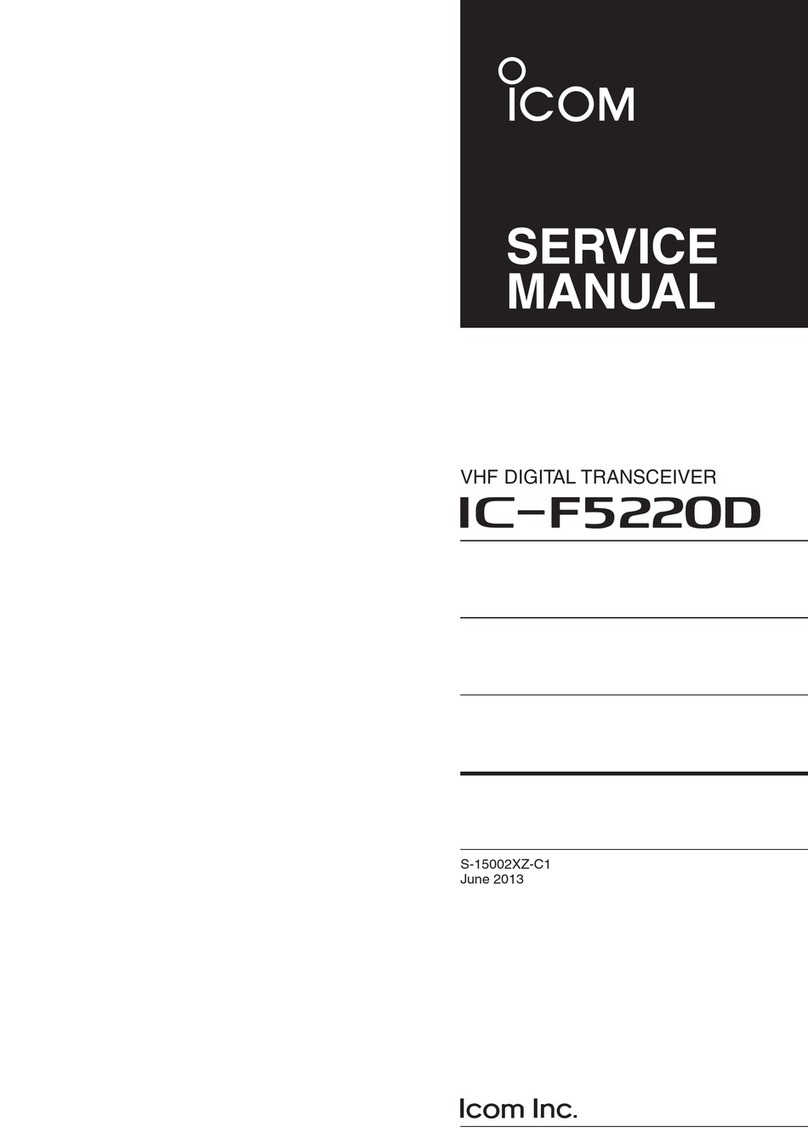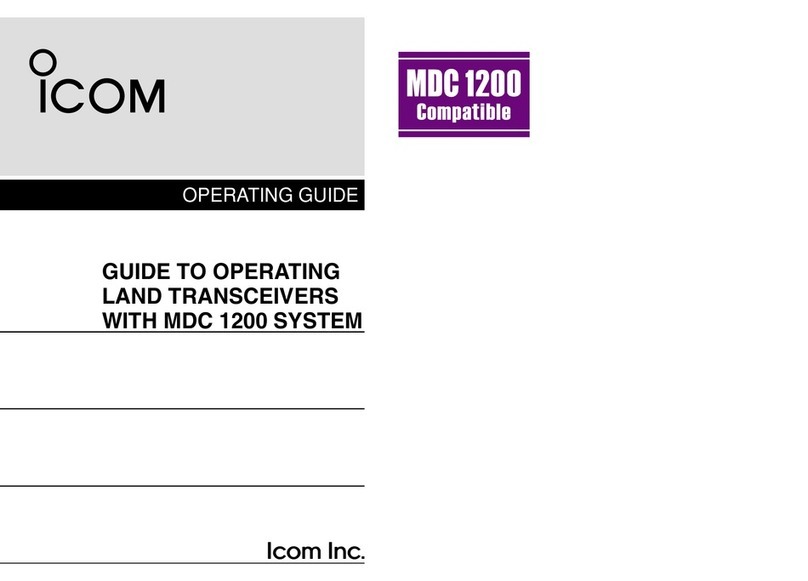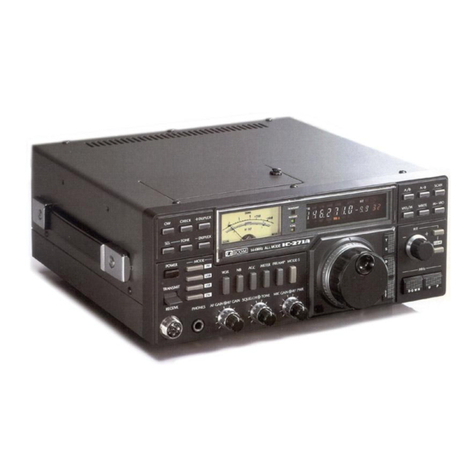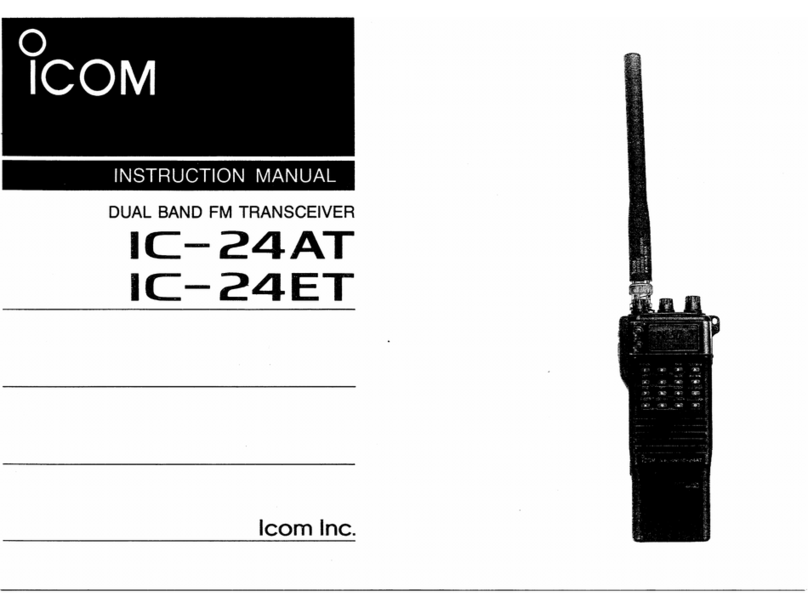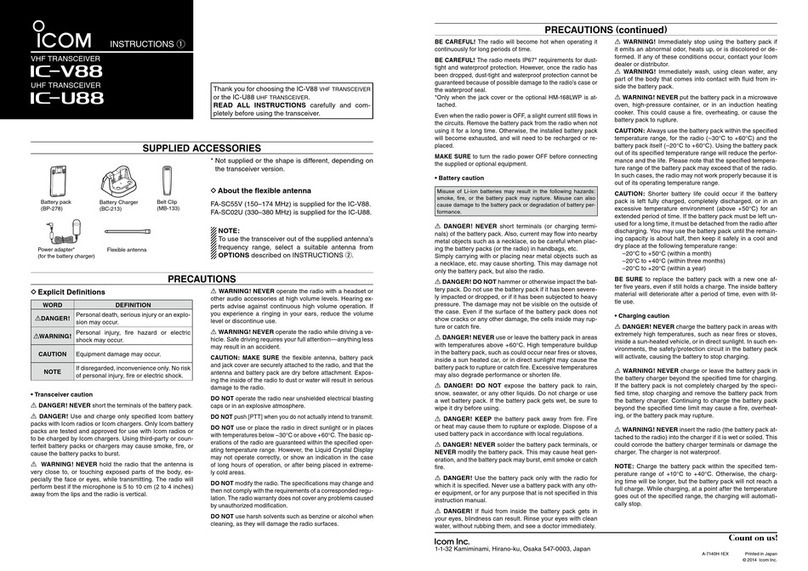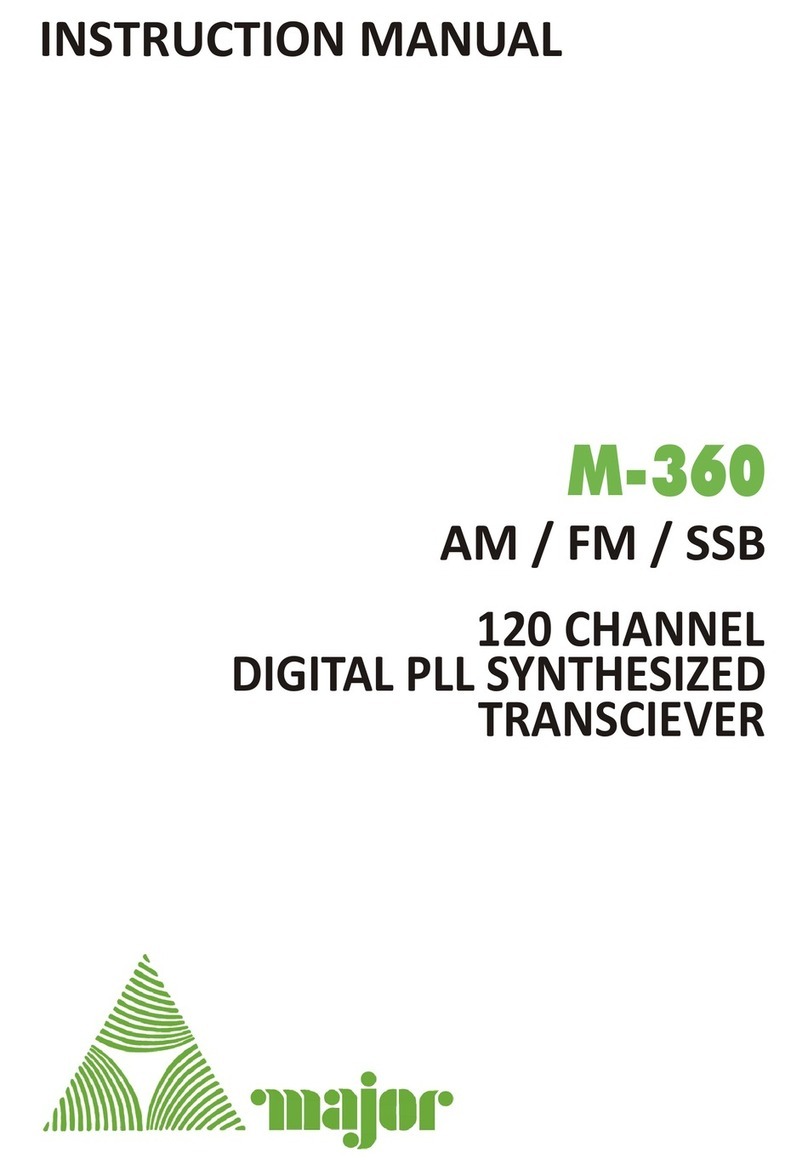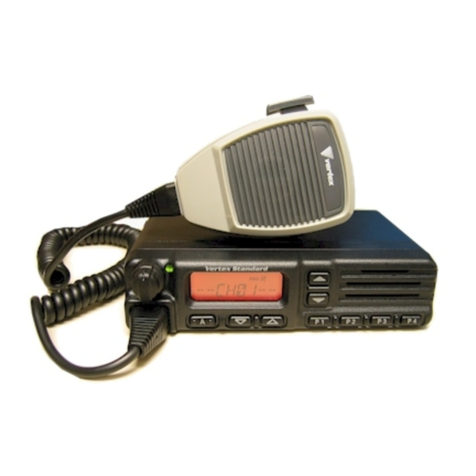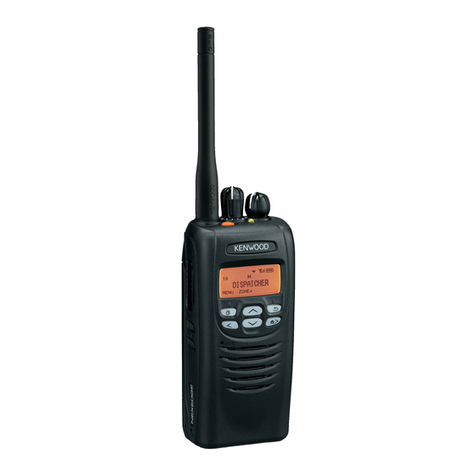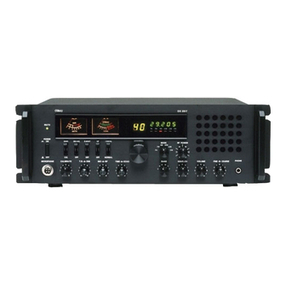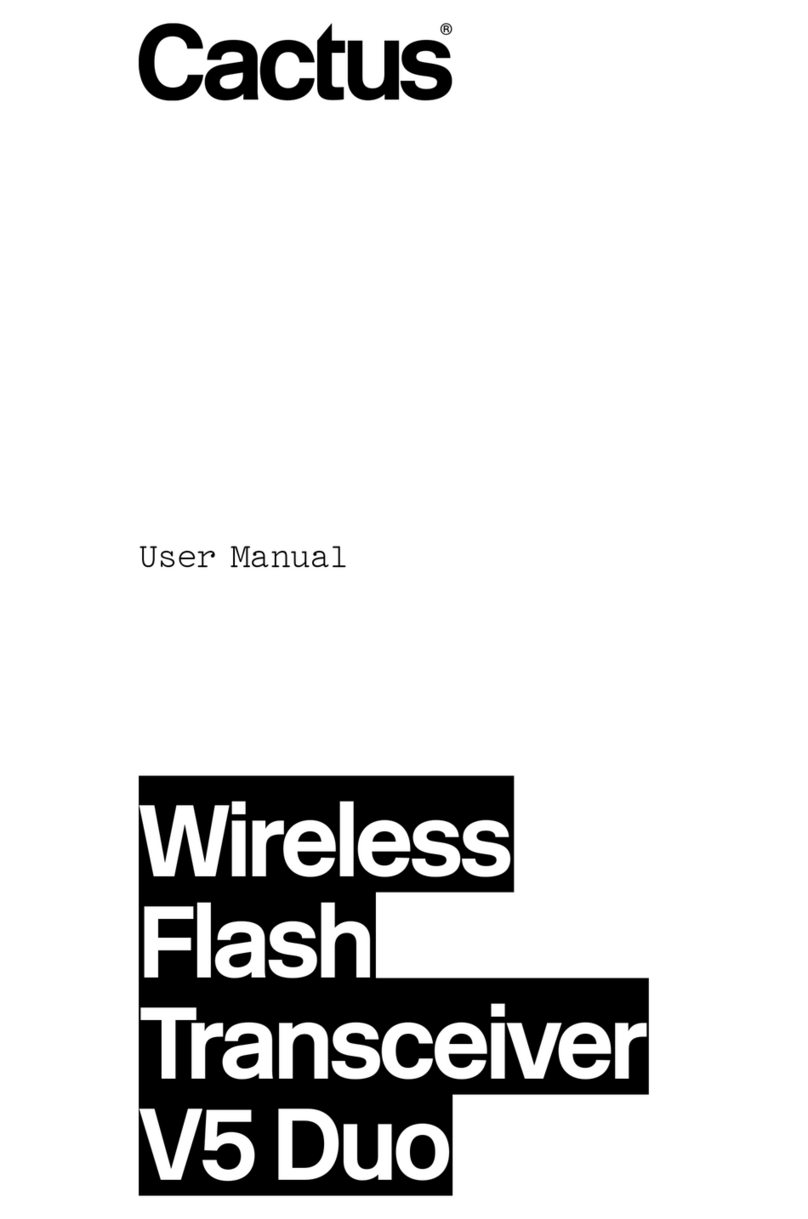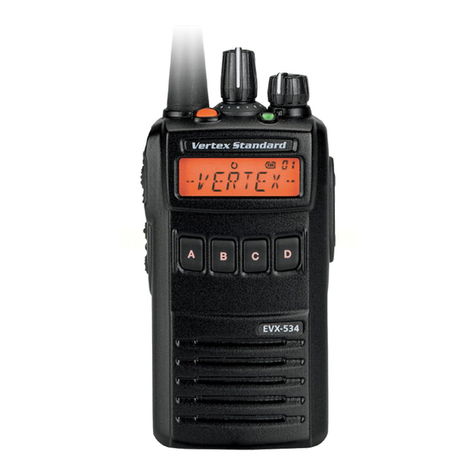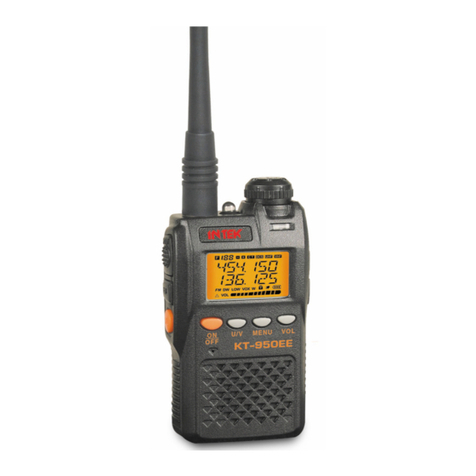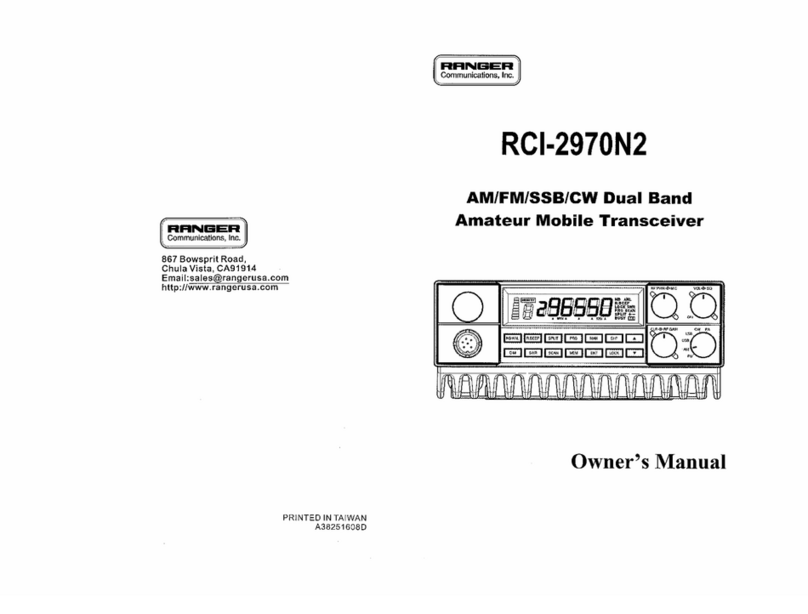Icom IC-80AD User manual

S-14528XZ-C1
Apr. 2009
VHF/UHF DIGITAL TRANSCEIVER
All manuals and user guides at all-guides.com
all-guides.com

This service manual describes the latest technical
information for the IC-80AD and IC-E80D VHF/UHF
DIGITAL TRANSCEIVER at the time of publication.
NEVER connect the transceiver to an AC outlet or to a DC
power supply that uses more than specified. This will ruin
the transceiver.
DO NOT expose the transceiver to rain, snow or any liquids.
DO NOT reverse the polarities of the power supply when
connecting the transceiver.
DO NOT apply an RF signal of more than 20 dBm (100 mW) to
the antenna connector. This could damage the transceiver’s
front-end.
To upgrade quality, any electrical or mechanical parts
and internal circuits are subject to change without notice
or obligation.
MODEL VERSION TYPE OF
EMISSION
Max. TX POWER
(VHF/UHF)
IC-80AD
[USA]
F2D, F3E, F7W 5 W/5 W
[SEA]
[CHN]
[KOR]
[AUS]
[EXP]
IC-E80D
[EUR]
[UK]
[ITR]
[FRA]
Be sure to include the following four points when ordering
replacement parts:
1. 10-digit Icom parts numbers
2. Component name
3. Equipment model name and unit name
4. Quantity required
<ORDER EXAMPLE>
1110003491 S.IC TA31136FNG IC-E80D/80AD MAIN UNIT 5 pieces
8820001210 Screw 2438 screw IC-E80D/80AD Top cover 10 pieces
Addresses are provided on the inside back cover for your
convenience.
Icom, Icom Inc. and ICOM logo are registered trademarks of Icom Incorporated (Japan) in the United States, the United
Kingdom, Germany, France, Spain, Russia and/or other countries.
ORDERING PARTS
1. Make sure that the problem is internal before
disassembling the transceiver.
2. DO NOT open the transceiver until the transceiver is
disconnected from its power source.
3. DO NOT force any of the variable components. Turn
them slowly and smoothly.
4. DO NOT short any circuits or electronic parts. An
insulated tuning tool MUST be used for all adjustments.
5. DO NOT keep power ON for a long time when the
transceiver is defective.
6. DO NOT transmit power into a Standard Signal
Generator or a Sweep Generator.
7. ALWAYS connect a 50 dB to 60 dB attenuator between
the transceiver and a Deviation Meter or Spectrum
Analyzer when using such test equipment.
8. READ the instructions of test equipment throughly
before connecting a test equipment to the transceiver.
REPAIR NOTES
INTRODUCTION
CAUTION
(IC-80AD)
UNIT ABBREVIATIONS:
F=FRONT UNIT
L=LOGIC UNIT
M=MAIN UNIT
V=VCO UNIT
R=RF UNIT
All manuals and user guides at all-guides.com

TABLE OF CONTENTS
SECTION 1 SPECIFICATIONS
SECTION 2 INSIDE VIEWS
SECTION 3 DISASSEMBLY INSTRUCTION
SECTION 4 CIRCUIT DESCRIPITON
4-1 RECEIVER CIRCUITS. . . . . . . . . . . . . . . . . . . . . . . . . . . . . . . . . . . . . . . . . . . . . . . . . . . . . . . . 4-1
4-2 TRANSMITTER CIRCUITS . . . . . . . . . . . . . . . . . . . . . . . . . . . . . . . . . . . . . . . . . . . . . . . . . . . . 4-4
4-3 FREQUENCY SYNTHESIZER CIRCUITS . . . . . . . . . . . . . . . . . . . . . . . . . . . . . . . . . . . . . . . . 4-5
4-4 CPU (LOGIC UNIT: IC1) PORT ALLOCATION . . . . . . . . . . . . . . . . . . . . . . . . . . . . . . . . . . . . . 4-6
4-5 VOLTAGE BLOCK DIAGRAM . . . . . . . . . . . . . . . . . . . . . . . . . . . . . . . . . . . . . . . . . . . . . . . . . . 4-7
SECTION 5 ADJUSTMENT PROCEDURE
5-1 PREPARATION . . . . . . . . . . . . . . . . . . . . . . . . . . . . . . . . . . . . . . . . . . . . . . . . . . . . . . . . . . . . . 5-1
5-2 FREQUENCY ADJUSTMENT . . . . . . . . . . . . . . . . . . . . . . . . . . . . . . . . . . . . . . . . . . . . . . . . . . 5-3
5-3 IDLING CURRENT ADJUSTMENT (at 5.0 V) . . . . . . . . . . . . . . . . . . . . . . . . . . . . . . . . . . . . . . 5-3
5-4 IDLING CURRENT ADJUSTMENT (at 7.4 V) . . . . . . . . . . . . . . . . . . . . . . . . . . . . . . . . . . . . . . 5-4
5-5 IDLING CURRENT ADJUSTMENT (at 13.5 V) . . . . . . . . . . . . . . . . . . . . . . . . . . . . . . . . . . . . . 5-5
5-6 TRANSMIT POWER ADJUSTMENT (at 5.0 V). . . . . . . . . . . . . . . . . . . . . . . . . . . . . . . . . . . . . 5-6
5-7 TRANSMIT POWER ADJUSTMENT (at 7.4 V). . . . . . . . . . . . . . . . . . . . . . . . . . . . . . . . . . . . . 5-6
5-8 TRANSMIT POWER ADJUSTMENT (at 13.5 V). . . . . . . . . . . . . . . . . . . . . . . . . . . . . . . . . . . . 5-7
5-9 DEVIATION ADJUSTMENTS . . . . . . . . . . . . . . . . . . . . . . . . . . . . . . . . . . . . . . . . . . . . . . . . . . 5-8
5-10 TONE DEVIATION ADJUSTMENTS . . . . . . . . . . . . . . . . . . . . . . . . . . . . . . . . . . . . . . . . . . . . . 5-9
5-11 RECEIVE SENSITIVITY ADJUSTMENT. . . . . . . . . . . . . . . . . . . . . . . . . . . . . . . . . . . . . . . . . . 5-10
5-12 S-METER ADJUSTMENT . . . . . . . . . . . . . . . . . . . . . . . . . . . . . . . . . . . . . . . . . . . . . . . . . . . . . 5-12
SECTION 6 PARTS LIST
SECTION 7 MECHANICAL PARTS
SECTION 8 BOARD LAYOUTS
SECTION 9 BLOCK DIAGRAM
SECTION 10 VOLTAGE DIAGRAM
LOGIC UNIT . . . . . . . . . . . . . . . . . . . . . . . . . . . . . . . . . . . . . . . . . . . . . . . . . . . . . . . . . . . . . . . 10-1
MAIN UNIT. . . . . . . . . . . . . . . . . . . . . . . . . . . . . . . . . . . . . . . . . . . . . . . . . . . . . . . . . . . . . . . . . 10-3
RF UNIT. . . . . . . . . . . . . . . . . . . . . . . . . . . . . . . . . . . . . . . . . . . . . . . . . . . . . . . . . . . . . . . . . . . 10-5
VCO UNIT . . . . . . . . . . . . . . . . . . . . . . . . . . . . . . . . . . . . . . . . . . . . . . . . . . . . . . . . . . . . . . . . . 10-7
All manuals and user guides at all-guides.com

1 - 1
SECTION 1
.
SPECIFICATIONS
Version TX RX
U.S.A. 144–148, 420–450*10.495–823.990,
849–868.990,
894–999.990
S.E.A.
CHN
EXP
137–174*2, 400–470*20.495–999.990
KOR 144–146, 430–440 144–146, 430–440
AUS 144–148, 420–450*20.495–999.990
*
1Guaranteed 440–450 MHz only, *2Guaranteed 430–440 MHz only
• Mode :
FM, FN-N, AM (Rx only), WFM (Rx only), DV
• No. of memory channels : 1052
(incl. 50 scan edges and 2 call channels)
• Usable temp. range : –20°C to +60°C; –4°F to +140°F
• Tuning steps : 5‡, 6.25‡, 8.33‡, 9‡, 10, 12.5, 15‡, 20,
25, 30, 50, 100, 125 and 200 kHz
DGeneral
Version TX RX
U.S.A. 144–148, 420–450*10.495–823.990,
849–868.990,
894–999.990
S.E.A.
CHN
EXP
137–174*2, 400–470*20.495–999.990
KOR 144–146, 430–440 144–146, 430–440
AUS 144–148, 420–450*20.495–999.990
*
1Guaranteed 440–450 MHz only, *2Guaranteed 430–440 MHz only
All stated specifications are subject to change without notice or obligation.
• Frequency stability : ±2.5 ppm
(–20°C to +60°C; –4°F to +140°F)
• Power supply : 10.0–16.0 V DC for external DC power,
or specified Icom’s battery pack
• Digital transmission speed: 4.8 kbps
• Voice coding speed : 2.4 kbps
• Current drain (at 7.4 V DC) :
Tx High 144 MHz 1.8 A typical
430/440 MHz 2.1 A typical
Tx Mid. 144 MHz 1.2 A typical
430/440 MHz 1.5 A typical
Tx Low 144 MHz 0.6 A typical
430/440 MHz 0.7 A typical
Tx S-Low 144 MHz 0.4 A typical
Rx Rated output 170 mA typical (FM)
215 mA typical (DV)
Power save 30 mA typical (FM)
(Duty 1:4) 38 mA typical (DV)
standby 62 mA typical (FM)
106 mA typical (DV)
• Antenna connector : SMA (50 Ω)
• Dimensions : 58.4(W)×103(H)×34.2(D) mm;
(projections not included) 2
5⁄16(W)×41⁄16(H)×111⁄32(D) in
• Weight (approx.) : 290 g; 10.3 oz (with antenna and BP-217)
DTransmitter
• Modulation system :
FM Variable reactance freq. modulation
DV (Digital) GMSK reactance freq. modulation
• Output power (at 7.4 V DC)
(Typical) : High 5.0 W, Mid. 2.5 W, Low 0.5 W,
S-Low 0.1 W
• Max. frequency deviation : ±5.0 kHz (FM wide: approx.)
±2.5 kHz (FM narrow: approx.)
• Spurious emissions : Less than –60 dBc at High/Mid.
Less than –13 dBm at Low/Slow
• Ext. mic. impedance : 2 kΩ
DReceiver
• Receive system :
Except WFM Double-conversion superheterodyne
WFM Triple-conversion superheterodyne
• Intermediate frequencies :
1st 61.65 MHz/59.25 MHz (WFM only)
2nd 450 kHz/13.35 MHz (WFM only)
3rd 1.95 MHz (WFM only)
• Sensitivity (except spurious points):
FM
(1 kHz/3.5 kHz Dev.; 12 dB SINAD)
1.625–29.995 MHz 0.4 μV typ.
30.000–75.995 MHz 0.25 μV typ.
76.000–117.995 MHz 0.25 μV typ.
118.000–173.995 MHz 0.14 μV typ.
174.000–259.995 MHz 0.32 μV typ.
260.000–349.995 MHz 0.32 μV typ.
350.000–469.995 MHz 0.16 μV typ.
470.000–599.995 MHz 0.32 μV typ.
600.000–999.990 MHz 0.56 μV typ.
WFM
(1 kHz/52.5 kHz Dev.; 12 dB SINAD)
76.000–108.000 MHz 1 μV typ.
175.000–221.995 MHz 1.8 μV typ.
470.000–770.000 MHz 2.5 μV typ.
AM
(1 kHz/30% Mod.; 10 dB S/N)
0.495–4.995 MHz 1.3 μV typ.
5.000–29.995 MHz 0.56 μV typ.
118.000–137.000 MHz 0.5 μV typ.
222.000–246.995 MHz 0.79 μV typ.
247.000–329.995 MHz 1 μV typ.
DV
(PN9/GMSK 4.8ksps; BER 1%)
VHF (Amateur band only) 0.22 μV typ.
UHF
(Amateur band only) 0.22 μV typ.
• Audio output power : More than 300 mW at 10% distortion
(at 7.4 V DC) with an 8 Ωload
• Selectivity :
FM (Wide), AM More than 50 dB
FM (Narrow), DV More than 45 dB
WFM More than 300 kHz/–3 dB
Less than 700 kHz/–20 dB
• Ext. speaker connector : 3-conductor 3.5(d) mm; (1⁄8˝)/8 Ω
• Spurious and image rejection ratio :
VHF More than 60 dB
UHF More than 50 dB
(Intermediate freq.; More than 60 dB)
• Squelch Sensitivity (except spurious points):
FM (1 kHz/3.5 kHz Dev.)
1.625–29.995 MHz 0.4 μV typ.
30.000–75.995 MHz 0.25 μV typ.
76.000–117.995 MHz 0.25 μV typ.
118.000–173.995 MHz 0.14 μV typ.
174.000–259.995 MHz 0.32 μV typ.
260.000–349.995 MHz 0.32 μV typ.
350.000–469.995 MHz 0.16 μV typ.
470.000–599.995 MHz 0.32 μV typ.
600.000–999.990 MHz 0.56 μV typ.
WFM (1 kHz/52.5 kHz Dev.)
76.000–108.000 MHz 1 μV typ.
175.000–221.995 MHz 1.8 μV typ.
470.000–770.000 MHz 2.5 μV typ.
AM (1 kHz/30% Mod.)
0.495–4.995 MHz 1.3 μV typ.
5.000–29.995 MHz 0.56 μV typ.
118.000–137.000 MHz 0.5 μV typ.
222.000–246.995 MHz 0.79 μV typ.
247.000–329.995 MHz 1 μV typ.
<For IC-80AD>
<For IC-E80D>
‡
Selectable depending on the operating
frequency band.
(unit: MHz)
(unit: MHz)
All manuals and user guides at all-guides.com

2 - 1
SECTION 2
.
INSIDE VIEWS
• LOGIC UNIT
VCC LINE SWITCH
(IC104)
EEPROM
(IC51)
ALC AMP
(IC300)
DIGITAL/ANALOG
MODE SWITCH
(IC303)
AF FILTER
(IC501 )
AF BUFERF
(IC504)
LINEAR CODEC
(IC503)
+5 V SWITCHING REGULATOR
(IC102)
AF MUTE SWITCHES
(Q403, 404)
IDC
(IC302)
3.3V REGULATOR
(Q507)
MIC GAIN SWITCH
(Q303)
MIC LINE SWITCH
(IC301)
1/2 DIVIDER
FOR MODEM CLOCK
(IC500)
AF POWER AMP
(IC400)
CPU3V REGULATOR
(IC100)
LCD DRIVER
(IC603)
DSP CODEC
(IC506)
DSP CLOCK AMP
(IC505)
BUFFER for DSP CLOCK
(IC505)
All manuals and user guides at all-guides.com

2 - 2
• MAIN UNIT
(TOP VIEW)
• MAIN UNIT
(BOTTOM VIEW)
SERIAL/PARALLEL
CONVERTER
(IC701)
AF FILTER
(IC501)
TONE FILTER
(IC150)
RX AF LINE SWITCH
(IC500)
REFERENCE FREQUENCY
SIGNAL BUFFER
(Q450)
SERIAL/PARALLEL
CONVERTER
(IC702)
T5V REGULATOR
(Q804)
2ND IF FILTER (WIDE/NARROW)
SELECTOR
(Q153)
IF IC
(IC100)
1ST IF FILTER (WFM)
(FI2)
1ST IF FILTER (FM/AM/DV)
(FI50)
CURRENT DETECT
(IC800)
2ND IF FILTER
(WIDE MODE)
(FI200)
D/A CONVERTER
(IC600)
RF AMP
(Q700)
2ND IF AMP (WFM)
(Q1)
2ND IF MIXER (WFM)
(Q2)
FM/WFM MODE SWITCH
(Q201)
DISCRIMINATOR
(X100)
T5V REGULATOR
(Q805)
REFERENCE FREQUENCY
OSCILLATOR
(X450)
2ND IF FILTER
(NARROW MODE)
(FI100)
DETECT VOLTAGE
SELETCOR
(BATTERY/DC-IN)
(IC1000)
AGC VOLTAGE DETECTOR
(Q104)
IF AMP
(Q103)
All manuals and user guides at all-guides.com
all-guides.com

1 - 1
TX POWER AMPLIFIER
(Q100)
VCO UNIT
• RF UNIT
R3V LINE SWITCH
(Q251, 303, 703) HV LINE SWITCH
(Q1000)
RF CIRCUITS SHIFT SWITCH
(Q252, 302)
TX LO AMPLIFIER
(IC100)
All manuals and user guides at all-guides.com

FLAT
CABLE
LOGIC unit
A
B
B
B
B
Front panel
E
D
B
B
B
A
C
Rear panel
A
A
A
DD
B
BB
RF UNIT
Rear panel
C
RF UNIT
Rear panel
MAIN UNIT
3 - 1
1. Removing the rear panel
qUnscrew 2 screws Aand remove the plate B.
w Unscrew 2 screws Cand 2 screws D.
e Disconnect the flat cable Efrom MAIN UNIT.
r Remove the rear panel.
3. Removing the RF UNIT
qUnsolder 2 points A.
wUnsolder 3 points Band remove the shield plate C.
eUnscrew 4 screws Dand remove the RF UNIT from the
rear panel.
2. Removing the MAIN UNIT
qUnsolder 5 points A.
wUnscrew 3 screws B.
eRemove the MAIN UNIT from the rear panel.
4. Removing the LOGIC UNIT
1Unsolder 2 points A.
2 Unscrew 6 screws Band remove the LOGIC UNIT
from the front panel.
SECTION 3
.
DISASSEMBLY INSTRUCTION
BE CAREFUL about the flat cable and connector when
separating the CHASSIS UNIT from the FRONT UNIT.
All manuals and user guides at all-guides.com

4 - 1
SECTION 4
.
CIRCUIT DESCRIPTION
4-1 RECEIVER CIRCUITS
RF CIRCUITS (RF UNIT)
RX signals from the antenna are sorted by its frequency by
the filters and gone through RF circuits for each bands.
• 76 MHz and below
The RX signals are passed through two LPFs, ANT SW,
band SW and LPF. The RX signals are sorted by its
frequency by band SWs.
• 0.495–29.995 MHz
The RX signals are passed through the band SW (D201)
and LPF, and applied to tuned RF AMP (Q200). The
amplified RX signals are applied to the 1st mixer (IC900) via
two band SWs (D203 and D707).
• 30–75.995 MHz
The RX signals are passed through the band SW (D250) and
tuned BPF, and applied to the RF AMP (Q250). The amplified
RX signals are passed through tuned BPF, then applied to
the 1st IF mixer (IC900) via two band SWs (D256 and D707).
• 76–117.995 MHz
The RX signals are passed through two LPFs, ANT SW, band
SW (D300), LPF and another band SW (D301) in sequence,
then applied to the RF AMP (Q300) via the tuned BPF. The
amplified RX signals are passed through another tuned BPF,
then applied to another RF AMP (Q301). The amplified RX
signals are applied to the 1st mixer (IC900) via two band SWs
(D311
and D707
).
• 118–173.995 MHz
The RX signals are passed through two LPFs, ANT SW, and
band SW (D400), then applied to the RF AMP (Q400). The
amplified RX signals are passed through the tuned BPF, and
applied to another RF AMP (Q401). The amplified RX signals
are passed through tuned BPF, then applied to the 1st IF
mixer (IC900) via two band SWs (D405 and D509).
• 174–259.995 MHz
The RX signals are passed through the LPF, HPF, ANT
SW, ATT, band SW (D302), HPF and another band SW in
sequence, then applied to the RF AMP (Q300) via the tuned
BPF. The amplified RX signals are passed through another
tuned BPF, then applied to another RF AMP (Q301). The
amplified RX signals are applied to the 1st mixer (IC900) via
two band SWs (D311 and D707).
• 260–349.995 MHz and 470–599.995 MHz
The RX signals are passed through the LPF, HPFANT SW,
ATT, BAND SW and tuned BPF in sequence, then applied to
the RF AMP (Q500). The amplified RX signals are passed
through another 2-pole tuned BPF, and applied to another
RF AMP (Q501). The amplified RX signals are then applied
to the 1st mixer (IC900) via two band SWs
(D508 and
D707)
.
• 350–469.995 MHz
The RX signals are passed through the LPF, HPF, ANT
SW, ATT, band SW and HPF in sequence, then applied to
the RF AMP (Q600). The amplified RX signals are passed
through the tuned BPF, and applied to the RF AMP (Q601).
The amplified RX signals are passed through the BPF, then
applied to the 1st mixer (IC900) via two band SWs (D606
and D707).
• 600–999.990 MHz
The RX signals are passed through the HPF, ATT and
applied to the RF AMP (Q700). The amplified RX signals
are passed through the tuned BPF, and applied to another
RF AMP (Q701). The amplified RX signals are applied to
the 1st mixer (IC900) via the band SWs (D706 and D707).
The RF attenuation which reduces RX signal level to –10 dB is
carried out by D5, D9 and D701, by turning these PIN diodes
ON using "ATT" signal.
RF
AMP
ANT
SW
RF
AMP
RF
AMP
LPF
BAND
SW
BPF
BAND
SW
RF
SW
RF
AMP
RF
SW
LPF
BAND
SW
BPF
RF
AMP
HPF
BPF
HPF
BPF
BAND
SW
RF
AMP
LPF
BAND
SW
RF
AMP
RF
AMP
BPF
LPF
RF
AMP
BAND
SW
ATT
LPF
BAND
SW
BPF
BPF
BAND
SW
RF
AM P
ANT
SW
BAND
SW
BAND
SW
BAND
SW
BAND
SW
BPF
BAND
SW
BAND
SW
BPF
BAND
SW
BPF
RF
AMP
RF
AMP
HPF
BPF
Q1,2,150
D1,3,4,10,151,160
Q1,3,D6-8
RF UNIT
D304,305
Q601
D604,605
D606
D400
Q401
Q701
D402,403
D405
D200
D250
D254,255
D508
D253
D705
D603
D311
Q400
Q700
D201
Q500
D252
D600
D300
Q300
D302
D401
D703,704
D404
D706
D500
Q200
D503
D251
D256
Q600
D301
D306-309
Q301
D303
D 700
D501,502
D203
BAND
SW
D203
D504,507
Q250
Q501
D202
D601,602
To 1st mixer
(IC900)
for A BAND
From the VHF TX
circuits
From the UHF TX
circuits
D310
0.5−30 MHz
30−76 MHz
Tx: 430.000−450.000 MHz
Tx: 144.000−148.000 MHz
174−260 MHz
76−118 MHz
118−174MHz
470−600 MHz
260−350 MHz
350−470 MHz
600−1000MHz
HPF
L1-3
C1-6
L4,C7-9
L200,201
C201-204
L300,301
C301-305
L600,608
C600-602,630,631
L8,9
C18-20
L302,303
C306-310
L202,203
C205-9
L5-7
C10-14
• RF CIRCUITS
All manuals and user guides at all-guides.com

4 - 2
1ST IF CIRCUIT (MAIN UNIT)
The RX signals from the RF circuits are applied to the 1st
mixer (RF: IC900) to be converted into the 1st IF signal,
by being mixed with the 1st Local Oscillator (LO) signals
from the VCO UNIT. The 1st LO signals from the VCO UNIT
are applied to the 1st mixer via the LO SW, or doubler (in
receiving of 600 MHz and above).
The converted 1st IF signal is passed through the IF SW (D2)
which toggles the path of the 1st IF signal: WFM mode or
other than WFM mode.
• FM/AM/DV MODE
The 1st IF signal from the 1st mixer (RF: IC900) is entered
to the MAIN UNIT, and passed through the 1st IF filter (FI50)
via IF SWs (D2, 3) to remove unwanted signals. The filtered
1st IF signals are applied to the 1st IF AMP (Q100), and the
amplified 1st signal is applied to the 2nd IF circuit.
• WFM MODE (Incl. 2nd IF circuit)
When receiving in WFM mode, the 1st IF signal from the 1st
mixer (RF: IC900) is entered to the MAIN UNIT and passed
through the IF SW (D2) and BPF, then applied to the 1st IF
AMP (Q1). The amplified 1st IF signal is applied to the 2nd
mixer (Q2) to converted into the 13.35 MHz 2nd IF signal,
by being mixed with the 45.9 MHz 2nd LO signal (generated
by X450, tripled by Q451). The converted 2nd IF signal is
passed through the 2nd IF filter (FI2) to remove sideband
noise, then applied to the 2nd IF AMP (Q100) via the IF SW
(D3). The amplified 2nd IF signal is applied to the 3rd IF
circuit.
2ND IF AND DEMODULATOR CIRCUITS (MAIN UNIT)
<For FM, AM and DV mode>
The 1st IF signal from the 1st IF AMP (Q100) is applied to
the IF IC (IC100). The applied 1st IF signal is mixed with
the 61.2 MHz 2nd LO signal (generated by X450, buffered
by Q452) at the internal 2nd mixer, to be converted into the
450 kHz 2nd IF signal. The converted 2nd IF signal is output
from pin 3.
• FM MODE
The 2nd IF signal from the IF IC is passed through the 2nd
IF filter (FI100) via IF SWs (D102, 103). The filtered 2nd
IF signal is backed to the IF IC from pin 5, and saturation-
amplified by the internal limit AMP. The amplified 2nd IF
signal is FM-demodulated by the discriminator (X100), and
the recovered AF signals (RX AF signals) are output from
pin 9, then applied to the AF circuits via the FM mode SW
(IC500D, pins 8, 9).
• AM MODE
The 2nd IF signal from the IF IC is passed through the 2nd
IF filter (FI200) via IF SWs (D150, 151). The filtered 2nd IF
signal is amplified by 2nd IF AMP (Q103), then applied to
the AM demodulator circuit (Q104) to be recovered to the
AF signals. The demodulated AF signals are applied to the
AF circuits via the AM mode SW (IC500A).
• DV MODE
The 2nd IF signal from the IF IC is passed through the 2nd
IF filter (FI100) via IF SWs (D102, 103). The filtered 2nd
IF signal is backed to the IF IC from pin 5, then saturation-
amplified by the internal limit AMP. The amplified 2nd IF
signal is FM-demodulated by the discriminator (X200), and
the recovered AF signals (RX AF signals) are output from
pin 9, then applied to the AF circuits via the AF mute SW
(IC500, pins 4, 3).
• 3RD IF CIRCUIT (MAIN UNIT)
<For WFM mode only>
The 2nd IF signal from the 2nd IF AMP (Q100) is applied to
the IF IC.
The applied 2nd IF signal is mixed with the 15.3 MHz 3rd
LO signal (generated by X450, buffered by Q452), to be
converted into the 1.95 MHz 3rd IF signal by the internal 3rd
mixer. The converted 3rd IF signal is output from pin 3, and
passed through the IF SWs (D105, 106), then backed to the
IF IC (bypassing FI100). The 3rd IF signal is FM-demodulated
by the discriminator (X100), and the recovered AF signals
(RX AF signals) are output from pin 9, then applied to the AF
circuits via the WFM mode SW (IC500C, pins 8, 9).
X2
BPF
XTAL
LO
SW
BPF
CERAMIC
IF
AM P
VCOs
From the RF
circuits
IF
AM PBPF
SW
M ODE
MAIN UNIT
SW
M ODE
15.3MHz
Reference frequency
oscillator
FM/AM/DV:61.65 MH
z
WFM:13.35 MH
z
TX circuits
D100
Q850
IC900
1st IF mixer
D2
FI2
FI50
D3
Q100
To the IF IC
(IC100)
X450
VCO UNIT
D850
BC BAND; Q1,2,D1-3,5,6
VHF BAND; Q51,52,D51-55
UHF BAND; Q101,102,D100-104
X3
Q451
Q2
BPF
CERAMIC
BPF
CERAMIC
IF
AM P
AM
DET
SW
MODE
FM
DET
DISCRI
MODE
MAIN UNIT
SW
M ODE
SW
FM61.2MHz
WFM15.3MHz
From the IF AMP (Q100)
X1
or
X4
Q452D450
FI200
FI100
SW
M ODE
SW
MODE
D 150D151
D102
Q103
Q104
SW
MODE
IC500A
To the AF filter
(IC501)
To the mode Sw
(IC501)
To the buffer
(IC504B)
SW
MODE
IC500D
SW
MODE
IC500C
AM
FM
WFM
IC100
X100
15.3MHz
X450
D105
D106
D103
• 1ST IF CIRCUIT
• 2ND IF AND DEMODULATOR CIRCUITS
All manuals and user guides at all-guides.com

4 - 3
RX AF CIRCUITS (LOGIC UNIT)
• FM/W-FM/AM MODE
The AF signals from the FM/AM demodulator circuits are
passed through the mode SW (MAIN UNIT: IC500D/C/A)
and one of the AF filters whose audio frequency response
is set as stable for each RX mode (FM/AM or WFM).
FM/AM-demodulated AF signals are filtered by IC501, and
FM-demodulated AF signals (W-FM mode) are filtered by
Q552.
The filtered AF signals are passed through the D/A
converter (MAIN UNIT: IC600, pins 15, 14; 16, 17) for level
adjustment. The level-adjusted AF signals are entered to the
LOGIC UNIT, and applied to the AF power AMP (IC400) to
obtain audio output power. The power-amplified AF signals
are applied to the internal speaker or output from the [SP]
jack.
• DV MODE
The FM-demodulated signals from the IF IC (MAIN UNIT:
IC100) are applied to the modem (IC501) via the LPF and
buffer (IC504B), to be converted into the DV data. The DV
data is applied to the CPU (IC1), and converted into the
AMBE signals. The AMBE signal is then applied to the DSP
CODEC IC (IC506) and decoded. The decoded AMBE
signals are converted into the analog audio signal by liner
CODEC IC (IC503). The converted AF signals are passed
through the mode SW (MAIN UNIT: IC500B) and AF filter
(MAIN UNIT: IC501A).
The filtered AF signals are passed through the D/A
converter (MAIN UNIT: IC600, pins 15, 14; 16, 17) for level
adjustment. The level-adjusted AF signals are entered to the
LOGIC UNIT, and applied to the AF power AMP (IC400) to
obtain audio output power. The power-amplified AF signals
are applied to the internal speaker or output from the [SP]
jack.
SP
AF
AMP
BUFF
LPF
CPU
Q400-402
POWER AMP
CONTROLLER
MODEM
DSP
CODEC
LINEAR
CODEC
IC600
IC400
LOGIC UNIT MAIN UNIT
CHASSIS
[SP]
IC503
IC506
IC504B
IC501
IC1
IC501
SW
SW
FIL
IC500A
M ODE
IC500D
M ODE
<FM/AM/ MODE>
AM/FM-demodulated AF signals from
AM mode SW (IC500A)/FM mode SW (IC500D)
<WFM MODE>
FM-demodulated AF signals from
WFM mode SW (IC500C)
<DV MODE>
FM-demodulated AF signals from
IF IC (IC100)
AF
D/A
AFON
AF
FIL
Q552
15
4
3
8
11
2
6
1
14
6711
20,21
16
17
2
6
DAC Noise
AMP
Noise filter
From IF IC
(IC100, Pin16)
To RX AF circuits
Noise
detector
Com-
parator
NOISE SQUELCH DIAGRAM
“NOIS”
IC600
IC100
9
8
7
13
10
SQUELCH CIRCUIT
The squelch circuit cuts off the AF output signals when
no RF signals are received. Detecting noise components
(approx. 30 kHz signals) in the demodulated AF signals, the
squelch circuit stops audio signals being emitted.
A portion of FM-demodulated AF signal from the IF IC (MAIN
UNIT: IC100) is passed through the DAC (MAIN UNIT:
IC600) for level (=threshold) adjustment. The level-adjusted
AF signals are passed through the noise filter (IC100, pins 7,
8 and R111–113, C121, 122) to filter the noise components
(approx. 30 kHz signals) only. The noise components are
rectified to produce DC voltage corresponding to the noise
level.
If the noise level is higher than the preset one, the internal
comparator set the "NOISE" signal to the CPU to "High",
then the CPU turns the "AFON" signal which controlls the
AF power AMP (L: IC400) to "Low," to inactivate the AF
power AMP (L: IC400). At the same time, the CPU turns the
"RMUTE" signal which controlls the AF mute SW (L: Q403,
404) to "Low," to cut-off the RX AF line.
• RX AF CIRCUITS
All manuals and user guides at all-guides.com
all-guides.com

4 - 4
4-2 TRANSMITTER CIRCUITS
TX AF CIRCUITS (LOGIC UNIT)
• FM MODE
MIC signals from the internal/external microphone (MIC
signals) are passed through the MIC gain SW (Q303),
and applied to the MIC AMP (Q302, 304). The amplified
MIC signals are passed through the mode SW (IC301)
which toggles the MIC line according to the operating
mode; FM or DV. The MIC signals are applied to the IDC
(Instance Deviation Controller; IC302B) circuit which limits
the amplitude of MIC signals (=deviation) to prevent over
deviation.
The amplitude-limited MIC signals are passed through
the splatter filter (IC302C) which cuts off the 3 kHz and
higher audio signals. The frequency-limited MIC signals are
entered to the MAIN UNIT via the mode SW (IC303), then
applied to the DAC (MAIN UNIT: IC600) for level (=deviation)
adjustment. The level-adjusted MIC signals are applied to
the modulation circuits.
• DV MODE
The MIC signals from the microphone (MC300) are passed
through the MIC gain SW (Q303) and applied to the MIC
AMP (Q302, 304). The amplified MIC signals are applied
to the ALC AMP (IC300) which automatically adjusts the
level of MIC signals to stable for digital processing, via
the mode SW (IC301). The level-adjusted MIC signals are
applied to the IDC circuit (IC302B) for amplitude-limiting.
The amplitude-limited MIC signals are passed through the
splatter filter (IC302C) which cuts off the 3 kHz and higher
audio signals.
The frequency-limited MIC signals are applied to the liner
CODEC IC (IC503) via the buffer (IC504A), and encoded
into the digital audio signal. The digital audio signal is then
applied to the DSP CODEC IC (IC506) and converted into
the AMBE signal. The AMBE signal is applied to the modem
IC (IC501) via the CPU (IC1). The modem IC converts the
AMBE signal into the analog signal, and output to the DAC
(IC600, pin 1) via the buffer (IC302D) and the mode SW
(IC303). The tone signal is level-adjusted by DAC (MAIN
UNIT: IC600), then applied to the modulation circuits as the
modulation signals.
MODULATION CIRCUITS (VCO UNIT)
The modulation signals from the DAC (MAIN UNIT: IC600,
pin 2) are entered to the VCO UNIT, and applied to the
variable capacitors of VCOs.
• OPERATING ON VHF BAND
The modulation signals are applied to the D55 of the VHF
VCO (Q51, 52, D51–55) to obtain FM modulation. The
FM-modulated VCO output is buffer-amplified by Q200,
amplified by Q201 then entered to the RF UNIT as TX
signal.
• OPERATING ON UHF BAND
The modulation signals are applied to the D100 of the UHF
VCO (Q101, 102, D100–104) to obtain FM modulation. The
FM-modulated VCO output is buffer-amplified by Q200,
amplified by Q201 then entered to the RF UNIT as TX
signal.
TX AMPLIFIERS (RF UNIT)
TX signal from VCO UNIT is applied to the LO AMP
(IC100) via the LO SW (D100). The amplified TX signal is
passed through the ATT (D101, 102) which is a port of the
APC circuit. The level-adjusted TX signal is amplified by
YGR (Q102), drive (Q101) and power (Q100) amplifiers in
sequence, to obtain TX output power. The power-amplified
TX signal is passed through the TX filters, power detector
and ANT SWs.
• OPERATION ON VHF BAND
The power-amplified TX signal from the power AMP (Q100)
is passed through the LPF, ANT SW (D9, 61, 62), power
detector (D59, 60) and two LPFs (as a harmonic filter), then
applied to the antenna via ANT connector (CHASSIS; J1).
• OPERATION ON UHF BAND
The power-amplified TX signal from the power AMP (Q100)
is passed through the BPF, power detector (D50, 53), ANT
SW, HPF and LPF (as a harmonic filter), then applied to the
antenna via ANT connector (CHASSIS; J1).
Modulation signals
to the VCO UNIT
MC300
MIC
AM P
BUFF
BUFF
LPF
ID C LPF
SPLATTER
ALC
AM P
CPU
MODEM
DSP
CODEC
LINEAR
CODEC
SW
MODE
IC302B
IC302C
IC302D
IC600
Q306,307
Q309
LOGIC UNIT
IC503
IC504A
IC506
IC501,502
IC3
MAIN UNIT
D/A
Q302,304
MODE
SW
IC301
IC300
CTCSS
SW
GAIN
IC303
Q303
From ext. microphone
1
6
7
1
2
16
5798
5
21
?
?
12 14
7
• TX AF CIRCUITS
All manuals and user guides at all-guides.com

4 - 5
ATT ANT
SW
PWR
DET
PWR
AM P LPF
LPF
APC
CTRL
YGR
AM P DRIVE
AM P
LPF
GATE
CTRL
HPF
TX/RX
SW
PWR
DET
ANT
SW
LO
AMP BPF
D101,102
IC150B
PSET
D59,60
Q100Q102
D50,53
Q101
IC100
D 100,850
IC150A
Q152 L1-3
C1-6
L100.101.153
C100-103,192
L102,103
C106,107
L5-7
C10-14
L4,C7-9
ANT
Q153
D154-156
D150,152,153
DSET
VHF TX signal
UHF TX signal
FILTER
LOOP
VCO
BUFF
BUFF
TX/RX
SW
PLL
IC
VCO
LO
AMP
VCO
LPF
RF UNIT
Q201 D850
IC800
UHF BAND:
319.175-538.345 MHz
VCO UNIT
Q101,102,D100-104
Q1,2,D1-3,5,6
Q51,52,D51-55
Q200
BC BAND: 62.145−131.645 MHz
Q202
1st LO signals
(A BAND)
D 100
VHF BAND:
131.350-235.645 MHz
15.3MHz reference frequency
Modulation signals
APC CIRCUIT (RF UNIT)
The APC (Automatic Power Control) circuit stabilizes
transmit output power to prevent transmit output power level
change which is caused by load mismatching or heat effect,
etc.
TX signal is passed through the power detector (VHF; D59,
60/UHF; D50, 53). The power detector rectifies a portion
of the TX signal and converts it into DC voltage which is in
proportion to the transmit output power. The detected voltage
is applied to the APC controller (IC150B). The TX power
setting voltage “PSET” is applied to another input terminal as
the reference voltage.
The output voltage is applied to the ATT (D101, 102) to con-
trol the attenuation level, to adjust the input level of the YGR
AMP (Q102) so that the TX output power is stable.
The setting of TX power is carried out by applying voltage
“PSET” to the APC controller (IC150B).
The output voltage of
the controller controls the bias of the drive and power AMPs
to reduce/increase the gain of these amplifiers to set the TX
output power to High, Mid., Low and S-Low.
4-3 FREQUENCY SYNTHESIZER CIRCUITS
VCOs
This transceiver has total of five VCOs; one RX VCO and
RX/TX VCOs on the VCO UNIT, and two RX VCOs on the
MAIN UNIT.
• BC BAND VCO (VCO UNIT; Q1, D1, 3, 5, 6)
The BC BAND VCO generates the 1st LO for BC band
(0.495–75.995 MHz) RX.
• VHF BAND VCO (VCO UNIT; Q51, D51, 54)
The VHF BAND VCO generates the 1st LO for VHF band
(76–173.995 MHz) RX, and also TX signal for the operation
on the VHF band.
• UHF BAND VCO (VCO UNIT; Q101, D101–104)
The UHF BAND VCO generates the LO for UHF band (174–
599.995 MHz) RX, and also TX signal for the operation on
the UHF band.
When receiving 600 MHz and higher signals, the UHF BAND
VCO oscillates 269.175–469.17 MHz 1st LO signals, and the
output signal is doubled by the doubler (MAIN UNIT; Q850,
D851) before being applied to the mixer (MAIN UNIT; IC900).
PLL (VCO AND MAIN UNITS)
The PLL circuit provides stable oscillation for both of the
transmit and 1st LO frequencies. By comparing the fedback
VCO output and the reference frequency signal, the oscillating
frequency is stabilized. The PLL output frequency is controlled
by the serial data including divide ratio from the CPU.
A portion of output signals from each VCO are fedback
to the PLL IC (MAIN UNIT: IC800) via buffers (VCO:
Q200, 202) and LPF. The applied VCO outputs are divided
by the prescaler and programmable divider, then phase-
compared with divided reference frequency from X450
(MAIN). The phase difference is output via the charge pump,
and applied to the VCOs as lock voltage via the loop filter.
When the oscillation frequency drifts, its phase changes
from that of the reference frequency, causing a lock voltage
change to compensate for the drift in the VCO oscillating
frequency.
• TX AMPLIFIERS AND APC CIRCUIT
• FREQUENCY SYNTHESIZER CIRCUITS
All manuals and user guides at all-guides.com

4 - 6
PIN
No.
LINE
NAME DESCRIPTION IN/
OUT STATUS CONDITION
3 PCON Transceiver power control. OUT H While the transceiver power is
ON.
4 AFMUTE AF mute signal to the AF mute SW (LOGIC UNIT: Q403, 404). OUT H AF mute.
5 MUTE TX mute signal. OUT H TX mute.
6 MICC MIC AMP (LOGIC UNIT: Q304) control signal to the MIC AMP controller
(LOGI UNIT: Q302). OUT L MIC AMP is activated.
7 AFON Control signal to the AF power AMP controller (LOGIC UNIT: Q400–402). OUT H AF power AMP (L: IC400) is
activated (Squelch open).
9BATT
Power supply select signal to the power supply selector (LOGIC UNIT:
IC1000). OUT H/L
H=Operated by the battery
pack.
L=Operated by an external
power source.
10,
11 MIC1, MIC2 MIC gain control signals to the MIC gain controller (LOGIC UNIT: Q303). OUT – –
12 ACQ ACQ signal to the modem (LOGIC UNIT: IC501). OUT H Synchronized.
14 RXDT RX data to the modem (LOGIC UNIT: IC501). IN – –
15 TXDT TX data to the modem (LOGIC UNIT: IC501). OUT – –
16 AMBEC DSP IC power line regulator (LOGIC: IC508) control signal. OUT H In DV mode operation.
18 DVC Liner CODEC IC power line regulator (LOGIC UNIT: Q503, 504) control
signal. OUT H In DV mode operation.
20 PTT [PTT] key input. (Pull-down) IN H The key is pushed.
21 DASTB2 Strobe signal to the DAC (MAIN UNIT: IC600). OUT – –
26 BTDET Battery attach detect. IN L A battery is attached.
27 RXCK RX clock to the modem (LOGIC UNIT: IC501). IN – –
28 TXCK TX clock to the modem (LOGIC UNIT: IC501). IN – –
34 LINH LCD driver (LOGIC UNIT: IC603) chip-enable signal. OUT L LCD display OFF.
35 LCE Strobe signal to the LCD driver (LOGIC UNIT: IC603). OUT – –
36 LDI Serial data to the LCD driver (LOGIC UNIT: IC603). OUT – –
37 LCL Clock to the LCD driver (LOGIC UNIT: IC603). OUT – –
38 BLED [BUSY] LED driver (LOGIC UNIT: Q201) control signal. OUT H While receiving (Squelch
open).
39 TXLED TX LED control signal. OUT H Lights ON. (While transmitting)
40 LLIGHT LCD backlight control signal. OUT L Backlight ON.
41 KLIGHT LCD/Key backlight driver (LOGIC UNIT: Q201) control signal. OUT L Lights ON.
42 AMBECLK AMBE clock signal to the DSP CODEC IC (LOGIC UNIT: IC506). OUT – –
43 AMBERXD AMBE RX data to the DSP CODEC IC (LOGIC UNIT: IC506). IN – –
44 AMBETXD AMBE TX data to the DSP CODEC IC (LOGIC UNIT: IC506). OUT – –
45 AMBESTB AMBE strobe signal to the DSP CODEC IC (LOGIC UNIT: IC506). OUT – –
46 NOIS Noise detect signal from the IF IC (MAIN UNIT: IC100). IN – –
47 AMBERES Reset signal to the liner CODEC IC and DSP CODEC IC (LOGIC UNIT:
IC503 and IC506). OUT – –
49 AMBEEPR AMBEEPR signal to the DSP CODEC IC (LOGIC UNIT: IC506). IN – –
50 DTCS Tone filter response switching signal. OUT H DTCS signals is in use.
51–
55 KR0–KR4 Key detect signal.
(Pushed button is detected according to the input voltage.) IN – –
56 SQL [SQL] key input. (Pull-up) IN L The key is pushed.
57 DIUD [DIAL] input (Phase B). IN – –
59 DICK [DIAL] input (Phase A). IN – –
61–
64 KS0–KS3 Key matrix ports. OUT – –
69 IOSTB Strobe signal to the expander (RF UNIT: IC951). OUT – –
70 IOSTB1 Strobe signal to the expanders (MAIN UNIT: IC701, 702). OUT – –
71 IOEN Output enable signal to the expanders (MAIN UNIT: IC701, 702). OUT – –
72 DASTB1 Strobe signal to the DAC (RF UNIT: IC950). OUT – –
73 PLLSTB Strobe signal to the PLL IC (MAIN UNIT: IC800). OUT – –
7 4 DATA Common serial data to the PLL ICs and DAC (LMX2313/ME15E03SL/
M62352AGP). OUT – –
75 CK Common clock signal to the the PLL ICs and DAC (LMX2313/
ME15E03SL/M62352AGP). OUT – –
4-4 CPU (LOGIC UNIT: IC1) PORT ALLOCATION
All manuals and user guides at all-guides.com

4 - 7
4-4 CPU PORT ALLOCATION (continued)
4-5 VOLTAGE BLOCK DIAGRAM
Voltage from the power supply is routed to the whole of the transceiver via regulators and switches.
DC-IN VCC +5V +3CPU
DC
SW
SW
REG
V3+
T
Q1000,
D1000, 1001 IC102
Q803−805
Q400−402
IC100
Q800, 801
IC103
Q150−153
D150, 151
TAB
Battery pack
T5
NOCP
CHGH CHGC TXC
VCO UNIT
BCVCOC
VVCOC
UVCOC
AF PWR AMP
(IC400)
AFON
AMBEC
CHG
T5
AF AMP
REG
REG
3.3V
REG
3.2V
REG
+5V
SW
+3V
3.2V
5V
DVC
+5V
REG
+3V
REG
VCO3V
SW
V5.5+
IC125
DC-DC
PIN
No.
LINE
NAME DESCRIPTION IN/
OUT STATUS CONDITION
77 RESET Reset signal from the reset IC (LOGIC UNIT: IC100). IN H –
79 UNLK Unlock signal from the PLL IC (MAIN UNIT: IC800). IN H PLL is locked.
85 RX232 RS-232 data (RXD). IN – –
86 TX232 RS-232 data (TXD). OUT – –
89 CLSFT Clock frequency shift signal to the clock oscillator (LOGIC UNIT: X1,
D13). OUT H –
90 PPS Power save mode control signal to theD PLL IC (MAIN UNIT: IC800). OUT L In power save mode.
91 CHGC Charging control signal to the charge circuit (LOGIC UNIT: Q150–153,
D150, 151) OUT H While charging.
92 CHGH Charging current control signal to the charging controller (LOGIC UNIT:
Q150, 152). OUT H Charging current increase.
97 TEMP
The voltage in proportion to the internal temperature.
The voltage divided by R66 (thermistor; LOGIC UNIT) and R67 (LOGIC
UNIT).
IN – –
98 RTONE Weather alert signals. IN – –
96 VIN DC voltage divided by the voltage detect resisters (LOGIC UNIT: R159
and R160). (Remaining battery capacity detection.) IN – –
99 CTONE CTCSS signals. IN – –
100 RSSI RSSI voltage from the IF IC (MAIN UNIT: IC100). IN – –
101 TX-V
• While operated by batteryRSSI voltage from the IF IC (MAIN UNIT:
IC100).
• While perated by external power supplyCurrent in TX from the I-V
converter (MAIN UNIT: IC800).
IN – –
102 TTEMP
The voltage in proportion to the TX power AMP (RF UNIT: Q100)
temperature.The voltage divided by R161 (thermistor; RF UNIT) and
R162 (RF UNIT).
IN – –
103 CTCOUT CTCSS/DTCS signals. OUT – –
104 DTMF Tone (DTMF, european tone: IC-E80D only) signals. OUT – –
109 CPUHV External power supply detection. IN L External power supply is
connected.
110 POWER [POWER] key input. (Pull-up) IN L The key is pushed.
111 D_AS Analog/Digital mode switching signal. IN H Analog mode.
113 ECK Clock to the EEPROM (LOGIC UNIT: IC51). OUT – –
114 ESIO Serial data to the EEPROM (LOGIC UNIT: IC51). IN/
OUT ––
116 CLIN Key detect signal. (Pushed button is detected by refering input voltage.) IN – –
118 CLOUT Cloning data. OUT – –
All manuals and user guides at all-guides.com

5 - 1
SECTION 5
.
ADJUSTMENT PROCEDURE
5-1 PREPARATION
¤ REQUIRED INSTRUMENTS
INSTRUMENTS SPECIFICATION INSTRUMENTS SPECIFICATION
DC Cables • OPC-254L (Optional product)
• Connects to battery terminals JIG cables
(See the illust below)
Power Supply
Output voltages : 13.5 V DC
7.4 V DC
5.0 V DC
Current capacity : More than 3 A
Multimeter Input impedance : 50 kΩ
Measuring range : 0.1–10V/0.01–5 A
RF Power Meter
(terminated type)
Measuring range : 0.1–10 W
Frequency range : 100–500 MHz
Impedance : 50
Ω
SWR : Less than 1.2 : 1
Standard Signal
Generator (SSG)
Frequency range : 0.1–1200 MHz
Output level : –20 to 90 dBµ
(–127 to 90 dBm)
Frequency Counter
Frequency range : 0.1–600 MHz
Frequency accuracy : ±1 ppm or better
Input level : Less than 1 mW
AC Millivoltmeter Measuring range : 10 mV to 10 V
Attenuator Power attenuation : 30 dB
Capacity : More than 10 W
Modulation
Analyzer
Frequency range : 30–600 MHz
Measuring range : 0 to ±10 kHz Audio Generator Frequency range : 300–3000 Hz
Output level : 1–500 mV
3-conductor 2.5 (d) mm
[MIC]
To [MIC] jack
[SP]
plug
(MIC)
(GND)
33 k
+−
AC
MILLIVOLTMETER
(10 mV to 10 V)
AUDIO GENERATOR
(300–3000 Hz/1–500 mV)
+−
PTT
+
4.7 µF
3-conductor 3.5 (d) mm plug
(CLONE)
(GND)
68 kΩ
To [SP] jack
MJIG CABLES
All manuals and user guides at all-guides.com
all-guides.com

5 - 2
Frequency Adjustment item
Transmit power
Mode
Selects next adjustment item Stores the value for the adjustment
Selects previous adjustment item
Adjusts the value for the item
JIG cables
(See the page 5-1)
To the [DC IN] jack
OPC-254L
:etihW
:kcalB
DC power supply
13.5 V/3 A
DC power supply
5.0 or 7.4 V/3 A
Be sure the polarity.
• Adjustments at 5.0 V and 7.4 V
• Adjustments at 13.5 V
POWER SUPPLY
JIG cables
(See the page 5-1)
Modulation analyzer
(DC measurable)
Attenuator
30 dB or 40 dB
to the antenna connector
Standard signal generator
–20 to 90 dBµ
(–127 to –17 dBm)
CAUTION:
DO NOT transmit while
SSG is connected to
the antenna connector.
RF power meter
6 W
Frequency
counter
Oscilloscope
MENTERING ADJUSTMENT MODE
qTurn the transceiver power OFF.
wConnect
JIG cables (See the page 5-1) to the [MIC] and [SP] jacks.
ePush and [SQL] and [8], turn the transceiver power ON.
Entering adjustment mode, the function display shows the adjustment item and conditions as below.
MCONNECTION
MQUITTING ADJUSTMENT MODE
qTurn the transceiver power OFF.
wDisconnect the JIG cable, then turn the power OFF.
All manuals and user guides at all-guides.com

5 - 3
5-2 FREQUENCY ADJUSTMENT
Select an adjustment item using [2] / [8], then set the adjustment value as specified using [DIAL].
ADJUSTMENT
ADJUSTMENT
ITEM
OPERATION VALUE
REFERENCE
FREQUENCY
[FR]
1 1) Set the power supply voltage to 7.4 V.
2) Connect an RF power meter to the antenna connector.
3) Loose couple a frequency counter to the antenna connector.
4) While transmitting, adjust the frequency using [DIAL], then push
[BAND] to store the adjustment value.
440.0000
MHz
(±200 Hz)
5-3 IDLING CURRENT ADJUSTMENT (at 5.0 V)
Select an adjustment item using [2] / [8], then set the adjustment value as specified using [DIAL].
ADJUSTMENT
ADJUSTMENT
ITEM OPERATION VALUE
DRIVE AMP
IDLING CURRENT
[ID5]
1 1) Set the power supply voltage to 5.0 V.
2) Connect an RF power meter to the antenna connector.
3) Connect a multimeter between the power supply and transceiver.
4) Set the item [IP5] to "00."
–
[VHF BAND] 2•While transmitting, adjust the idling current using [DIAL], then
push [BAND] to store the adjustment value.
180–230
mA
[UHF BAND] 3 150–200
mA
FINAL AMP
IDLING CURRENT
[IP5]
1 1) Set the power supply voltage to 5.0 V.
2) Connect an RF power meter to the antenna connector.
3) Connect a multimeter between the power supply and transceiver.
–
[VHF BAND] 2•While transmitting, adjust the idling current using [DIAL], then
push [BAND] to store the adjustment value. 200–300
mA
[UHF BAND] 3
NOTE: When "IDLING CURRENT" is adjusted, "TRANSMIT POWER" must be re-adjusted too.
All manuals and user guides at all-guides.com

5 - 4
5-4 IDLING CURRENT ADJUSTMENT (at 7.4 V)
Select an adjustment item using [2] / [8], then set the adjustment value as specified using [DIAL].
ADJUSTMENT
ADJUSTMENT
ITEM OPERATION VALUE
DRIVE AMP
IDLING CURRENT
[ID7]
1 1) Set the power supply voltage to 7.4 V.
2) Connect an RF power meter to the antenna connector.
3) Connect a multimeter between the power supply and transceiver.
4) Set the item [IP7] to "00."
–
[VHF BAND]
(Hi power)
2•While transmitting, adjust the idling current using [DIAL], then
push [BAND] to store the adjustment value.
180–230
mA
(Mid power) 3
(Low power) 4
(S-Low power) 5
[UHF BAND]
(Hi power)
6
150–200
mA
(Mid power) 7
(Low power) 8
(S-Low power) 9
FINAL AMP
IDLING CURRENT
[IP7]
1 1) Set the power supply voltage to 7.4 V.
2) Connect an RF power meter to the antenna connector.
3) Connect a multimeter between the power supply and transceiver.
–
[VHF BAND]
(Hi power)
2•While transmitting, adjust the idling current using [DIAL], then
push [BAND] to store the adjustment value. 1.15 A
(Mid power) 3650 mA
(Low power) 4250 mA
(S-Low power) 5
[UHF BAND]
(Hi power)
61.15 A
(Mid power) 7 650 mA
(Low power) 8250 mA
(S-Low power) 9
NOTE: When "IDLING CURRENT" is adjusted, "TRANSMIT POWER" must be re-adjusted too.
All manuals and user guides at all-guides.com

5 - 5
5-5 IDLING CURRENT ADJUSTMENT (at 13.5 V)
Select an adjustment item using [2] / [8], then set the adjustment value as specified using [DIAL].
ADJUSTMENT
ADJUSTMENT
ITEM
OPERATION VALUE
DRIVE AMP
IDLING CURRENT
[ID1]
1 1) Set the power supply voltage to 13.5 V.
(supplying from [DC IN])
2) Connect an RF power meter to the antenna connector.
3) Connect a multimeter between the power supply and transceiver.
4) Set the item [IP1] to "00."
–
[VHF BAND]
(Hi power)
2•While transmitting, adjust the idling current using [DIAL], then
push [BAND] to store the adjustment value.
180–230
mA
(Mid power) 3
(Low power) 4
(S-Low power) 5
[UHF BAND]
(Hi power)
6
150–200
mA
(Mid power) 7
(Low power) 8
(S-Low power) 9
FINAL AMP
IDLING CURRENT
[IP1]
1 1) Set the power supply voltage to 13.5 V.
(supplying from [DC IN])
2) Connect an RF power meter to the antenna connector.
3) Connect a multimeter between the power supply and transceiver.
–
[VHF BAND]
(Hi power)
2•While transmitting, adjust the idling current using [DIAL], then
push [BAND] to store the adjustment value. 700 mA
(Mid power) 3400 mA
(Low power) 4250 mA
(S-Low power) 5
[UHF BAND]
(Hi power)
6900 mA
(Mid power) 7 400 mA
(Low power) 8250 mA
(S-Low power) 9
NOTE: When "IDLING CURRENT" is adjusted, "TRANSMIT POWER" must be re-adjusted too.
All manuals and user guides at all-guides.com
Other manuals for IC-80AD
3
This manual suits for next models
1
Table of contents
Other Icom Transceiver manuals
Popular Transceiver manuals by other brands
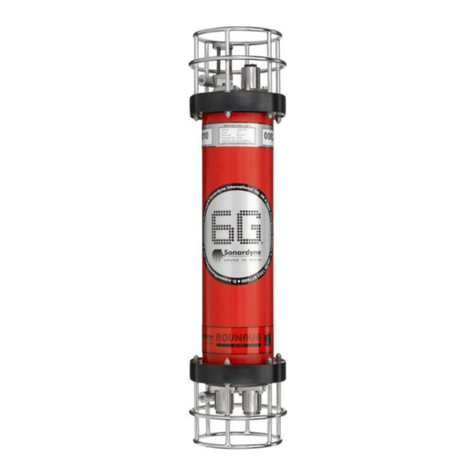
Sonardyne
Sonardyne 6G ROVNAV 6 quick start guide

SVSi
SVSi ATR-201 user manual

AUREL
AUREL RTX-868-NB user manual

MicroAir Avionics
MicroAir Avionics M760 Installation and user manual
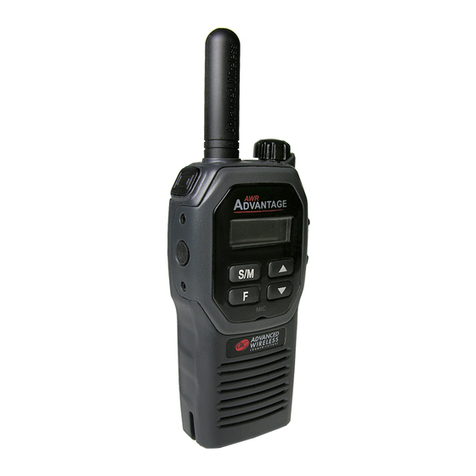
Advanced Wireless Communications
Advanced Wireless Communications AWR Advantage Plus quick start guide
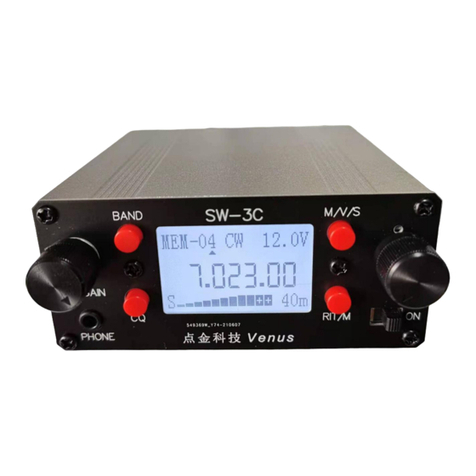
Venus
Venus SW-3C manual
